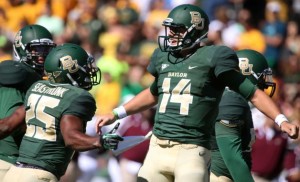1) For each game not played at a neutral site, 3 points are given to the road team. After that adjustment, all wins and losses of between 7 and 24 points are recorded exactly as such. This means that a 24-10 road win goes down as +17 for the road team, -17 for the home team.
2) With one exception, wins of 7 or fewer points are scored as 7-point wins and losses of 7 or fewer points are scored as 7 point losses. So a 4-point home win goes down as +7 (and not a 1) and a 1-point home loss is a -7 (and not a -4). The one exception is that road losses of 3 or fewer (and home wins of 3 or fewer) are graded as ties. So a 21-20 home victory goes down as a 0 for both teams.
3) Wins/Losses of more than 24 points are scored as the average between the actual number and 24. This is to avoid giving undue credit to teams that run up the score. So a 75-point home win goes down as a 48-point win.
Once we have a rating for each team in each game, we then adjust each result for strength of schedule. This is an iterative process, where we adjust the ratings hundreds of times (to adjust for SOS, you have to adjust for the SOS of each opponent, and the SOS of each opponent’s opponent, and so on.) in Excel. Then we produce final ratings, where the SRS rating is the sum of the Margin of Victory and Strength of Schedule in every week.
After five weeks, what are the results? As usual, the table is fully searchable (type “-0”, for example, to see a list of undefeated teams, or SEC to see all SEC teams.) Right now, the number one team is Baylor, with an average (adjusted) Margin of Victory of 41.5 points per game against an average opponent that is 27.7 points better than average (average includes all football teams at all levels, so all FBS will have a positive grade). Among undefeated teams, no opponent has faced a tougher SOS than Alabama. Below shows all 125 FBS teams.
Once again, I’ve set up a page that shows the results of every single FBS game this season. You can view that page here. The single best performance so far this season came by Stanford last week. In Seattle (technically a neutral site game), the Cardinal crushed a decent Washington State team, 55-17.
So why is Baylor, and not Alabama, number one in the SRS? Let’s get one thing out of the way: no, I don’t think Baylor would beat Alabama. The SRS doesn’t know how good these teams actually are — no preseason information is used — all it knows is how the teams have played to date. I am sure Alabama will pass Baylor soon, but for now, here’s the explanation: Baylor has only played three games, and won those games by an average of 62 points. One of them even came against a non-garbage MAC team (Buffalo). The Bulls aren’t good, of course, but they beat Connecticut, who was respectable against Maryland (#18) and nearly beat Michigan. So a beatdown against Buffalo makes Baylor look for real, to the extent any team can look for real after three games against weak teams. Bears quarterback Bryce Petty has thrown for 1,001 passing yards and 8 touchdowns on just 67 pass attempts, giving him a 17.3 AY/A average. Running back Lache Seastrunk, a former Oregon transfer, has averaged 11.0 yards per carry on 38 runs. There’s been nothing but fireworks in Waco, although we should keep expectations tempered. Beating an FCS school and two low-level BCS teams isn’t what made Robert Griffin III a Heisman Trophy winner, and the Bears still have nine conference games to navigate.
With the nonconference schedule now over, things should ease up…. in theory. But for Baylor, their next four games are against West Virginia, Kansas State, Iowa State, and Kansas, perhaps the four weakest teams in the Big 12. We should see Baylor run the schedule up to 7-0, and it wouldn’t surprise me if the Bears are in the top five by then.
As for Alabama? Well, they won a close game (according to the score board) in College Station, which just means that the Tide are considered very good and not a clear number one. And Alabama is docked a bit for only beating Colorado State by 25, since after all, Colorado beat the Rams by fourteen.
In any event, the ratings will get more accurate each week. For now, it’s too early to make any real conclusions. Finally, let’s look at each FBS team from week five, sorted from best to worst by SRS:

